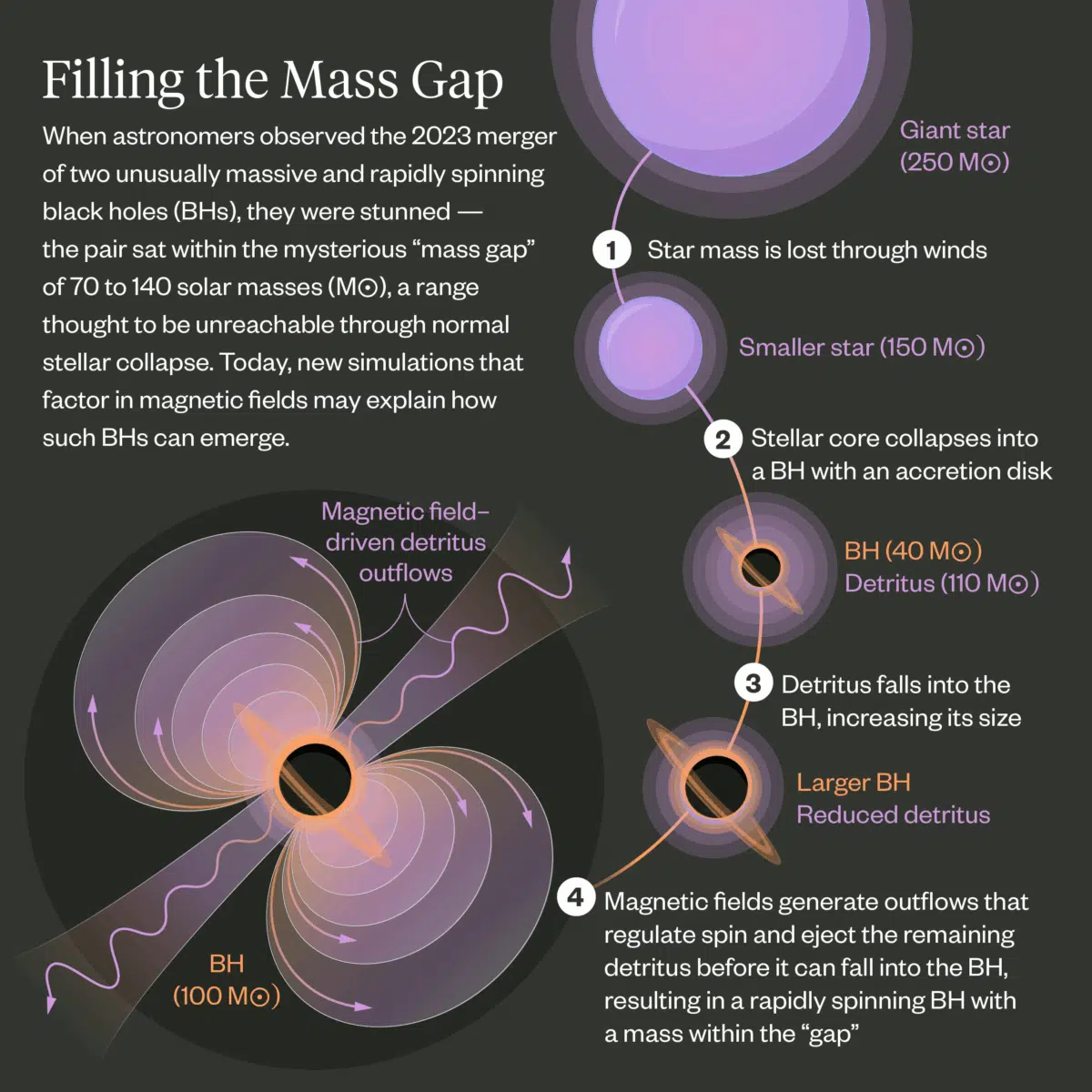In 2023, astronomers observed a black hole collision that defied established theories. Two enormous black holes spun into each other at nearly light speed, producing gravitational waves detected from billions of light-years away. What puzzled scientists was that these objects weren’t supposed to exist. A new simulation, however, may have just rewritten the rulebook.
A Mass Gap Mystery In The Cosmic Zoo
Black holes formed through supernovae are not expected to fall within a specific mass range — about 70 to 140 times the mass of the Sun. This limit arises from a phenomenon called pair-instability supernovae, which obliterates stars so completely that nothing is left behind. Yet the black holes observed in the 2023 event, GW231123, landed right in the middle of that forbidden range. This prompted astrophysicists to question long-held models of stellar death and black hole formation.
The event, captured through gravitational wave detectors operated by the LIGO-Virgo-KAGRA collaboration, also featured an unusual property: spin. The black holes were among the fastest rotators ever recorded, spinning so fast that they dragged spacetime around them. That level of spin should not survive a typical merger process, raising new questions about their origin.
To tackle the paradox, scientists at the Flatiron Institute’s Center for Computational Astrophysics (CCA) ran advanced end-to-end simulations of the stars’ evolution — a method not previously attempted in this way. Their work, published in The Astrophysical Journal Letters, introduces a key missing piece: magnetic fields.
“No one has considered these systems the way we did; previously, astronomers just took a shortcut and neglected the magnetic fields,” says Ore Gottlieb, lead author of the study. “But once you consider magnetic fields, you can actually explain the origins of this unique event.”
The Role Of Magnetic Fields In Shaping Black Hole Fate
The researchers simulated the life and collapse of a supermassive star, about 250 solar masses, starting from its hydrogen-burning phase to the moment of gravitational collapse. The simulation revealed that, after exhausting its fuel, the star would slim down to about 150 solar masses — just over the theoretical threshold for black hole formation. But what followed challenged prior assumptions.
Previous models assumed that the leftover debris from the collapse would fall entirely into the black hole, inflating its mass accordingly. But in the new simulation, rotation and magnetic fields changed everything. When the star’s remnants formed a spinning accretion disk around the newly formed black hole, magnetic pressure became a major player. Instead of feeding all the material into the black hole, these fields ejected massive amounts of stellar material into space — some at near-light speed.
“We found the presence of rotation and magnetic fields may fundamentally change the post-collapse evolution of the star, making black hole mass potentially significantly lower than the total mass of the collapsing star,” Gottlieb explains. This insight opens the door to a previously unrecognized pathway for forming mid-range black holes within the mass gap, without violating known laws of stellar evolution.
 An infographic describing the new work. Credit: Lucy Reading-Ikkanda/Simons Foundation
An infographic describing the new work. Credit: Lucy Reading-Ikkanda/Simons Foundation
Spin, Mass, And A Possible Universal Pattern
Magnetic fields didn’t just affect the mass. They also played a crucial role in controlling how fast the black hole spins. According to the study, stronger magnetic fields exert more braking force on the spinning disk, reducing spin and ejecting more material. Weaker fields allow more matter to fall into the black hole and result in faster-spinning, more massive black holes.
This link between spin and mass hints at a possible universal relationship: a pattern that could define how black holes evolve across the cosmos. It’s a bold idea, and one not yet testable, but the researchers suggest that gamma-ray bursts produced during these exotic collapses may offer clues. Observing these bursts — energetic beacons from across the universe — could confirm how common these rare events really are.
“As a result of these supernovae, we don’t expect black holes to form between roughly 70 to 140 times the mass of the sun,” Gottlieb says. “So it was puzzling to see black holes with masses inside this gap.” But with this new model incorporating rotation and magnetic feedback, the “impossible” now appears not only possible, but likely under certain conditions.

